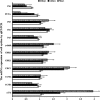Effects of aflatoxin B1 on the cell cycle distribution of splenocytes in chickens
- PMID: 30739993
- PMCID: PMC6361662
- DOI: 10.1293/tox.2018-0015
Effects of aflatoxin B1 on the cell cycle distribution of splenocytes in chickens
Abstract
The purpose of the present study was to evaluate effects of aflatoxin B1 (AFB1) on the cell cycle and proliferation of splenic cells in chickens. A total of 144 one-day-old Cobb male chickens were randomly divided into 2 equal groups of 72 each and were fed on diets as follows: a control diet and a 0.6 mg/kg AFB1 diet for 21 days. The AFB1 diet reduced body weight, absolute weight and relative weight of the spleen in broilers. Histopathological lesions in AFB1 groups were characterized as slight congestion in red pulp and lymphocytic depletion in white pulp. Compared with the control group, the expression levels of ataxia-telangiectasia mutated (ATM), cyclin E1, cyclin-dependent kinases 6 (CDK6), CDK2, p53, p21 and cyclin B3 mRNA were significantly increased, while the mRNA expression levels of cyclin D1, cdc2 (CDK1), p16, p15 were significantly decreased in the AFB1 groups. Significantly decreased proliferating cell nuclear antigen (PCNA) expression and arrested G0G1 phases of the cell cycle were also seen in the AFB1 groups. In conclusion, dietary AFB1 could induce cell cycle blockage at G0G1 phase and impair the immune function of the spleen. Cyclin D1/CDK6 complex, which inhibits the activin/nodal signaling pathway, might play a significant role in the cell cycle arrest induced by AFB1.
Keywords: AFB1; G0G1phase; cell cycle arrest; chicken; mechanism; spleen.
Figures






Similar articles
-
The molecular mechanism of cell cycle arrest in the Bursa of Fabricius in chick exposed to Aflatoxin B 1.Sci Rep. 2018 Jan 29;8(1):1770. doi: 10.1038/s41598-018-20164-z. Sci Rep. 2018. PMID: 29379099 Free PMC article.
-
The Protective Role of Selenium in AFB1-Induced Tissue Damage and Cell Cycle Arrest in Chicken's Bursa of Fabricius.Biol Trace Elem Res. 2018 Oct;185(2):486-496. doi: 10.1007/s12011-018-1273-6. Epub 2018 Mar 6. Biol Trace Elem Res. 2018. PMID: 29512029
-
Effect of Selenium Supplementation on Apoptosis and Cell Cycle Blockage of Renal Cells in Broilers Fed a Diet Containing Aflatoxin B1.Biol Trace Elem Res. 2015 Nov;168(1):242-51. doi: 10.1007/s12011-015-0344-1. Epub 2015 May 2. Biol Trace Elem Res. 2015. PMID: 25931191
-
The molecular mechanism of G2M cell cycle arrest induced by AFB1 in the jejunum.Oncotarget. 2016 Jun 14;7(24):35592-35606. doi: 10.18632/oncotarget.9594. Oncotarget. 2016. PMID: 27232757 Free PMC article.
-
The Molecular Mechanisms of Protective Role of Se on the G0/G1 Phase Arrest Caused by AFB1 in Broiler's Thymocytes.Biol Trace Elem Res. 2019 Jun;189(2):556-566. doi: 10.1007/s12011-018-1491-y. Epub 2018 Sep 10. Biol Trace Elem Res. 2019. PMID: 30203223
Cited by
-
Hypoxia and Cellular Senescence, Emerging Toxic Mechanisms of Mycotoxins and Toxins: A New Understanding of the Negative Immune Regulations.Toxins (Basel). 2022 Dec 16;14(12):880. doi: 10.3390/toxins14120880. Toxins (Basel). 2022. PMID: 36548777 Free PMC article. No abstract available.
-
AFB1 and OTA Promote Immune Toxicity in Human LymphoBlastic T Cells at Transcriptomic Level.Foods. 2023 Jan 6;12(2):259. doi: 10.3390/foods12020259. Foods. 2023. PMID: 36673351 Free PMC article.
-
Integrated Profiles of Transcriptome and mRNA m6A Modification Reveal the Intestinal Cytotoxicity of Aflatoxin B1 on HCT116 Cells.Genes (Basel). 2022 Dec 27;14(1):79. doi: 10.3390/genes14010079. Genes (Basel). 2022. PMID: 36672820 Free PMC article.
-
Integrated Transcriptome Analysis Reveals mRNA-miRNA Pathway Crosstalk in Roman Laying Hens' Immune Organs Induced by AFB1.Toxins (Basel). 2022 Nov 19;14(11):808. doi: 10.3390/toxins14110808. Toxins (Basel). 2022. PMID: 36422982 Free PMC article.
-
Characteristics, Occurrence, Detection and Detoxification of Aflatoxins in Foods and Feeds.Foods. 2020 May 18;9(5):644. doi: 10.3390/foods9050644. Foods. 2020. PMID: 32443392 Free PMC article. Review.
References
-
- Bryden WL. Mycotoxins in the food chain: human health implications. Asia Pac J Clin Nutr. 16(Suppl 1): 95–101. 2007. - PubMed
-
- Kalpana S, Aggarwal M, Srinivasa Rao G, and Malik JK. Effects of aflatoxin B1 on tissue residues of enrofloxacin and its metabolite ciprofloxacin in broiler chickens. Environ Toxicol Pharmacol. 33: 121–126. 2012. - PubMed
-
- Scott TR, Rowland SM, Rodgers RS, and Bodine AB. Genetic selection for aflatoxin B1 resistance influences chicken T-cell and thymocyte proliferation. Dev Comp Immunol. 15: 383–391. 1991. - PubMed
-
- Denissenko MF, Cahill J, Koudriakova TB, Gerber N, and Pfeifer GP. Quantitation and mapping of aflatoxin B1-induced DNA damage in genomic DNA using aflatoxin B1-8,9-epoxide and microsomal activation systems. Mutat Res. 425: 205–211. 1999. - PubMed
LinkOut - more resources
Full Text Sources
Research Materials
Miscellaneous

